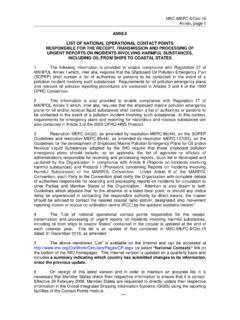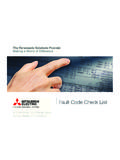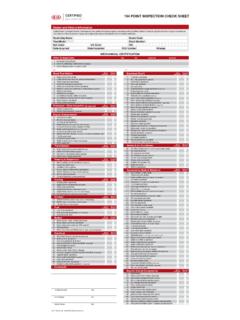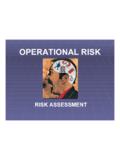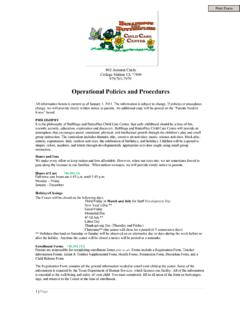Transcription of (Operational Delivery Guide) - HSE: Information …
1 Control of Major Accident Hazardsthe Competent AuthorityCOMAH Competent Authority Inspection of Competence Management Systems at COMAH Establishments (Operational Delivery Guide) Control of Major Accident Hazards2of 48 pagesInspection of Competence Management Systems at COMAH Establishments CONTENTS1 Introduction .. Background ..44 Purpose of the Programme ..45 Scope ..56 Targeting sites ..87 Legal Enforcement Part A: Competence Check Inspection ..10 i. What a Competence Check Inspection Looks ii. Walk and Talk Throughs ..11 iii. Pre-visit Information iv. Inspection v. Critical Tasks.
2 13 vi. Task Analysis ..13 vii. Procedures ..13 viii. Who should undertake the inspection?..14 ix. x. Judging success and moving on ..15 xi. Part A Inspections at Lower Tier COMAH xii. Table 1: Performance Rating following a Part A inspection ..1610. Part B: Competence Management Systems Inspection ..18 i. Pre-visit Information Key success and moving on ..19 2: Performance Rating following a Part B Annex 1: Introduction to Competence Management i. Competence Management System Annex 2: Competence Management System Toolkit ..2513. Annex 3: How the CMS Cycle aligns with HSG65 and Annex 4: Supplementary i.
3 Key principles in the Design of Critical and Maintaining the Competence of Annex 5: References and Supporting 48 Control of Major Accident Hazards3of 48 pagesInspection of Competence Management Systems at COMAH Establishments Introduction 1. Major hazard organisations require competent staff who have the necessary skills, knowledge and experience to undertake critical tasks in such a way as to prevent a major accident or minimise the consequences to people and the environment should one occur. 2. However, a review of major accidents across hazardous industries found that a lack of competence contributed to many of those incidents including: Southall Rail Crash; BP Texas City; Piper Alpha explosion and fire; the Esso Longford Gas plant explosion; and Buncefield.
4 3. The COMAH Competent Authority Intelligence Review Group (CAIRG) reviewed evidence from loss of containment incidents within the chemicals sector covering several years. The findings, set out in the HSL Annual operational Intelligence Report 2010, showed human error was, by far, the most frequent cause for loss-of-containment events . This was closely linked to inadequate procedures, poor plant design and unsuitable risk assessment. Justification 4. The HSE Chemicals Sector Strategy, developed in early 2011, identified that maintaining competence was a key challenge for industries within the sector.
5 Accordingly, CAIRG recommended that, based upon the evidence, the next strategic inspection topic for the CA should be competence management. Competence means the ability to undertake responsibilities and perform activities to arelevant standard, as necessary to ensure process safety and prevent major is a combination of knowledge, skills and experience and requires a willingness and reliability that work activities will be undertaken in accordance with agreedstandards, rules and procedures. Competence management means arrangements to control, in a logical and integratedmanner, a cycle of activities within the organisation that will assure, and develop, competent performance.
6 The aim is to ensure that individuals are clear about the performance that is expected of them, that they have received appropriate training, development and assessment, and that they maintain, or develop, their competence over of Major Accident Hazards4of 48 pagesInspection of Competence Management Systems at COMAH Establishments Background 5. Competence is a very broad subject area that may span the breadth and depth of an organisation. To verify every aspect of a competence management system could require a disproportionate amount of resource. Consequently, this Delivery guide details a targeted, proportionate and sampled competence intervention.
7 6. Most mature organisations will have a number of existing processes and procedures that can contribute to the overall competence picture. The following list, whilst not exhaustive, indicates some examples of those existing processes: performance management and review processes; incident investigation processes; workplace observation processes; recruitment processes; change management processes; sub standard performance / disciplinary processes; and recruitment and control of contractors processes. 7. Very often, the main challenge for COMAH Operators is a recognition that the above processes can contribute to their overall competence management system.
8 The subsequent challenge is then to ensure that there are effective arrangements in place, in order for these existing processes to inform the Operator s competence management system. Purpose of the Programme 8. The Competent Authority s (CA) purpose1is to deliver a regulatory framework that seeks to protect people and the environment from, and limit the consequences of, major accidents occurring within establishments covered by the COMAH Regulations. The CA s strategic aim is to enforce the regulations for the control of major accident hazards, by delivering a safety regime that: ensures that those responsible for creating risks meet their responsibilities to manage them, and that suitable emergency arrangements are in place; assures surrounding populations that activities at the site take into account their safety and that of the surrounding environment; and helps industry recognise that individual failures undermine the sector as a whole, and supports them in conducting their activities safely.
9 9. In June 2009 HSE published The health and safety of Great Britain Be part of the solution 2. One of the goals of the strategy is to reduce the likelihood of low-frequency, high-impact catastrophic incidents. Control of Major Accident HazardsInspection of Competence Management Systems at COMAH Establishments5of 48 pages Delivery guide (DG) underpins the CA programme to prevent, control and mitigate major accidents at COMAH sites by ensuring Operators adequately discharge their duty under COMAH Regulation 4 with regard to the management and attainment of competence for key personnel. DG helps the CA to identify those sites where competence compliance is a priority, and to assess the extent to which a competence management system is being effectively managed / implemented.
10 It should enable inspectors to: identify sites where competence, if not effectively managed, may have the potential to give rise to a major accident to both people and the environment; target inspections proportionate to the risk; assess how well an Operator is managing competence; record Operators CMS performance in a consistent way; identify compliance issues; secure improvements through proportionate and targeted enforcement; and arrange further interventions as necessary. Scope programme of inspections described within this DG is targeted at COMAH sites from 2012 to 2015.











